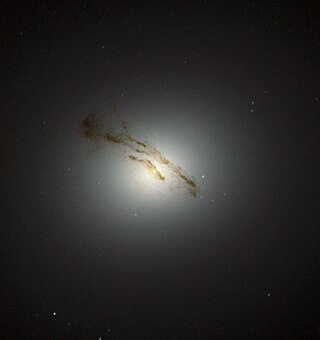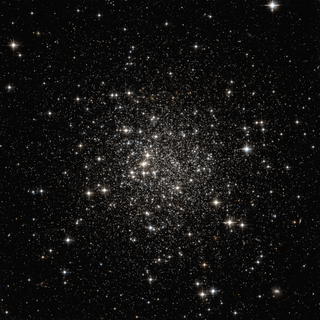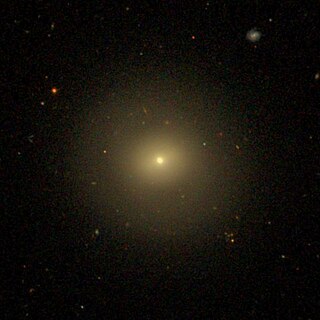
Messier 59 or M59, also known as NGC 4621, is an elliptical galaxy in the equatorial constellation of Virgo. It is a member of the Virgo Cluster, with the nearest fellow member 8′ away and around 5 magnitudes fainter. The nearest cluster member of comparable brightness is the lenticular galaxy NGC 4638, which is around 17′ away. It and the angularly nearby elliptical galaxy Messier 60 were both discovered by Johann Gottfried Koehler in April 1779 when observing comet seeming close by. Charles Messier listed both in the Messier Catalogue about three days after Koehler's discovery.

Messier 84 or M84, also known as NGC 4374, is a giant elliptical or lenticular galaxy in the constellation Virgo. Charles Messier discovered the object in 1781 in a systematic search for "nebulous objects" in the night sky. It is the 84th object in the Messier Catalogue and in the heavily populated core of the Virgo Cluster of galaxies, part of the local supercluster.

NGC 4881 is an elliptical galaxy in the northern constellation of Coma Berenices. It was discovered by the German astronomer Heinrich Louis d'Arrest on April 22, 1865. John L. E. Dreyer described it as "faint, small, a little extended, 9th magnitude star to southwest". This object is located at a distance of approximately 309 megalight-years from the Milky Way. It is a member of the Coma cluster of galaxies, positioned around 18′ to the north of the cluster's center with no nearby galactic neighbors.

NGC 1427 is a low-luminosity elliptical galaxy located approximately 71 million light-years away from Earth. It was discovered by John Frederick William Herschel on November 28, 1837. It is a member of the Fornax Cluster. The galaxy has a stellar mass of 7.9 × 1010M☉, and a total mass of 9.4 × 1010M☉. However, the mass of the dark matter halo surrounding the galaxy is around 4.3 × 1012M☉.

NGC 5170 is a large, nearby, edge-on spiral galaxy in the equatorial constellation of Virgo. It was discovered on February 7, 1785 by William Herschel. This galaxy is located at a distance of 83.5 million light years and is receding at a heliocentric radial velocity of 1,502 km/s. It is a member of the Virgo II Groups, a series of galaxies and galaxy clusters strung out from the southern edge of the Virgo Supercluster.

NGC 6522 is a globular cluster of stars in the southern constellation of Sagittarius. It was discovered by German-British astronomer William Herschel on June 24, 1784. The cluster has an apparent visual magnitude of 8.3 and an angular diameter of 9.4′. It is located at a distance of 25.1 kly (7.7 kpc) from the Sun, and lies in the Milky Way's central bulge, about 2.0 kly (0.6 kpc) from the Galactic Center. The cluster is centered in a region of the sky known as Baade's Window. It is highly impacted by reddening due to interstellar dust and the view is heavily contaminated by field stars, making it more difficult identify members.

NGC 6388 is a globular cluster of stars located in the southern constellation of Scorpius. The cluster was discovered by Scottish astronomer James Dunlop on May 13, 1826 using a 20 cm (9 in) reflector telescope. It was later determined to be a globular cluster by English astronomer John Herschel, who was able to resolve it into individual stars. NGC 6388 is located at a distance of approximately 35,600 light-years (10.90 kpc) from the Sun. Due to its apparent visual magnitude of +6.8, binoculars or a small telescope are required to view it.

NGC 121 is a globular cluster of stars in the southern constellation of Tucana. It is the oldest globular cluster in the Small Magellanic Cloud (SMC), which is a dwarf satellite galaxy of the Milky Way. This cluster was first discovered by English astronomer John Herschel on September 20, 1835. The compiler of the New General Catalogue, Danish astronomer John Louis Emil Dreyer, described this object as "pretty bright, pretty small, little extended, very gradually brighter middle". The cluster is located at a distance of around 200,000 light-years (60 kpc) from the Sun.

NGC 4147 is the New General Catalogue identifier for a globular cluster of stars in the northern constellation of Coma Berenices. It was discovered by English astronomer William Herschel on March 14, 1784, who described it as "very bright, pretty large, gradually brighter in the middle". With an apparent visual magnitude of 10.7, it is located around 60,000 light years away from the Sun at a relatively high galactic latitude of 77.2°.

NGC 1792 is a spiral galaxy located in the southern Columba constellation. It was discovered by Scottish astronomer James Dunlop on October 4, 1826. This galaxy is located at a distance of about 36.4 million light-years and is receding from the Milky Way with a heliocentric radial velocity of 1,208 km/s. NGC 1792 is a member of the NGC 1808 cluster of galaxies.

NGC 6426 is a globular cluster of stars located in the equatorial constellation of Ophiuchus. It was discovered by the German-English astronomer William Herschel on 3 June 1786. This cluster is at a distance of 67,000 light years from the Sun. It has an apparent visual magnitude of 10.9 and an angular diameter of 4.2′, making it difficult to observe with a small telescope.

NGC 3610 is an elliptical galaxy in the constellation Ursa Major. It was discovered on 8 April 1793 by German-British astronomer William Herschel. This galaxy is located at a distance of 106 million light-years (32.5 Mpc) from the Milky Way, and is receding with a galacto-centric radial velocity of 1,819 km/s.

NGC 3311 is a super-giant elliptical galaxy located about 190 million light-years away in the constellation Hydra. The galaxy was discovered by astronomer John Herschel on March 30, 1835. NGC 3311 is the brightest member of the Hydra Cluster and forms a pair with NGC 3309 which along with NGC 3311, dominate the central region of the Hydra Cluster.

NGC 708 is an elliptical galaxy located 240 million light-years away in the constellation Andromeda and was discovered by astronomer William Herschel on September 21, 1786. It is classified as a cD galaxy and is the brightest member of Abell 262. NGC 708 is a weak FR I radio galaxy and is also classified as a type 2 Seyfert galaxy.

NGC 2865 is an isolated elliptical galaxy in the equatorial constellation of Hydra. The core region of the galaxy shows a kinematically distinct component showing indications of a recent accretion or merger event that led to a burst of star formation around the nucleus. Observational constraints require this to have occurred within the last 100–400 million years, with the merger most likely being an Sb or Sc-class spiral galaxy.

NGC 3175 is a spiral galaxy located in the far eastern part of the southern constellation of Antlia at an approximate distance of 54 million light-years. NGC 3175 was discovered on March 30, 1835 by English astronomer John Herschel, whose notes described it as, "considerably bright, large, much extended NE-SW, very gradually little brighter middle". This galaxy is the namesake of the NGC 3175 group of galaxies, which includes the spiral galaxy NGC 3137.

NGC 6509 is a spiral galaxy in the equatorial constellation of Ophiuchus. It was discovered on July 20, 1879 by the French astronomer Édouard Stephan. This galaxy is located at a distance of 95.3 million light-years (29.22 Mpc) from the Milky Way, and is receding with a heliocentric radial velocity of 1,814 km/s.

NGC 4589 is an elliptical galaxy located in the Draco constellation. It was discovered by German-British astronomer William Herschel on November 22, 1797. This galaxy lies at a distance of 73.0 million light-years (22.39 Mpc) from the Milky Way, and is receding with a heliocentric radial velocity of 2,002 km/s. It is known by its designations PGC 42139 or UGC 7797.

NGC 3599 is a lenticular galaxy located in the constellation Leo. It was discovered by William Herschel on March 14, 1784. The galaxy is located at a distance of 67 million light-years (20.4 Mpc) from the Sun. NGC 3599 is a member of the Leo II group of galaxies in the Virgocentric flow.



















